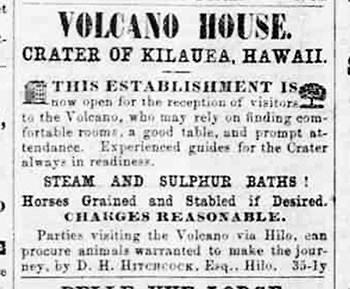
For information about staying at the modern Volcano House, see our Lodging page. 1846: The Pitman HouseThe earliest structure associated with Volcano House can be traced back all the way to 1846 when Benjamin Pitman constructed a four walled thatched shelter “in the native style.” Pitman was the husband of Princess Kinoʻole o Liliha Hoʻolulu and a prominent Hilo businessman. While Pitman’s building was in operation for nearly 20 years, accounts of the structure are inconsistent. By most accounts, his building was not always staffed and often in a state of disrepair. Lodging cost “a dollar a head per night, food extra”. The floor was dirt, and the interior featured a fireplace and little else. The only source of water at this shelter was an old canoe hung from the eves of the building that was often filled with a sludge of rain, sulfur and rotting vegetation from the thatched roof. The mixture was supposedly so foul that even the horses refused to drink it. This version of the inn was where the Volcano House register book originated. The guest book’s early volumes provide some of the oldest records of volcanic activity within the caldera and volumes continue to be in use today.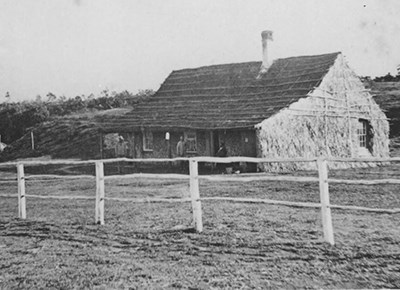
1866 Thatched Volcano HouseIn 1866, a much better constructed and comfortable thatched inn was built, a joint investment by local businessmen Charles and Julius Richardson, William Reed, J. C. King, L. G. Kaina and George W.C. Jones. This house had a wood floor, brick fireplace and by all accounts, excellent food. This is where the legacy of the modern Volcano House hotel begins.A warm fire, a good meal and a front row seat to the activity within the caldera became the hallmarks of a stay at Volcano House hotel. Mark Twain visited this inn shortly after it was built, famously remarking “The surprise of finding a good hotel in such an outlandish spot startled me considerably more than the volcano did. The house is new - built three or four months ago - and the table is good. One could not easily starve here even if the meats and groceries were to give out, for large tracts of land in the vicinity are well paved with excellent strawberries.” Royal Geographical Society traveler Isabella Bird visited in 1872. Bird remarked “The inn is a grass and bamboo house, very beautifully constructed without nails. It is a longish building with a steep roof divided inside by partitions which run up to the height of the walls. There is no ceiling. The joists which run across are concealed by wreaths of evergreens, from among which peep out here and there stars on a blue ground.” Kalākaua, the last king of Hawaiʻi, also visited during this time period. 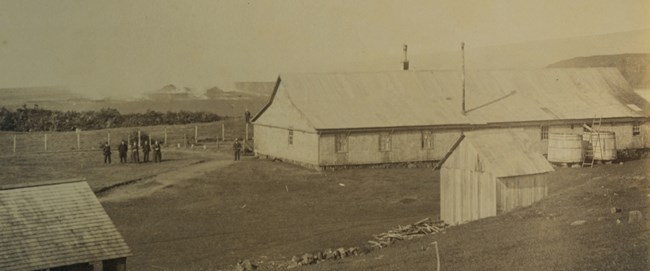
1877 Volcano HouseThe 1866 Volcano House had proven to be a successful venture, but the building was hard to maintain. William Lentz, a carpenter from Baltimore, built a more permanent western-style Volcano House hotel in 1877 located where koa trees near the pā hula (hula platform) is now. Native timber made up the structure which employed elaborate nail-less joints. Lentz imported redwood shingles from California and brought them to Kīlauea by mule. In 1885, the Wilder Steam Ship Company purchased Volcano House hotel and began a series of large investments to improve it. The most significant change was the reconstruction of the pier at Keauhou that had been destroyed during a 7.9 earthquake in 1868. With this, the company was able to offer all-inclusive travel and lodging from Honolulu to Kīlauea in a fraction of the time needed to port in Hilo or Kona. Famously, Princess Liliʻuokalani (who would later be the final monarch of the Hawaiian kingdom), witnessed the start of the 1880 rift zone eruption of Mauna Loa from Volcano House.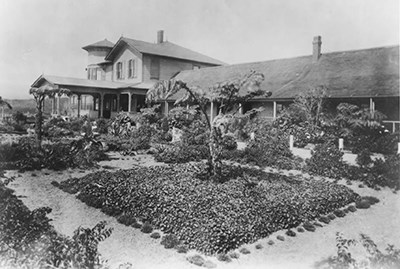
1891 Victorian AdditionBy 1891, the popularity of Volcano House hotel was booming. The hotel had traded hands again, this time to Lorrin A. Thurston, a Honolulu businessman and controversial historic figure. Thurston formed the “Volcano House Company” in partnership the three steamship companies that operated in Hawaiʻi at the time. In 1891, this partnership increased capacity of the hotel with a 2-story Victorian-style addition to the Kaʻū side of the building. Even with the addition, space in the hotel was barely enough for demand. At times, the lodge was so crowded that the billiard table in the parlor would be used as a bed.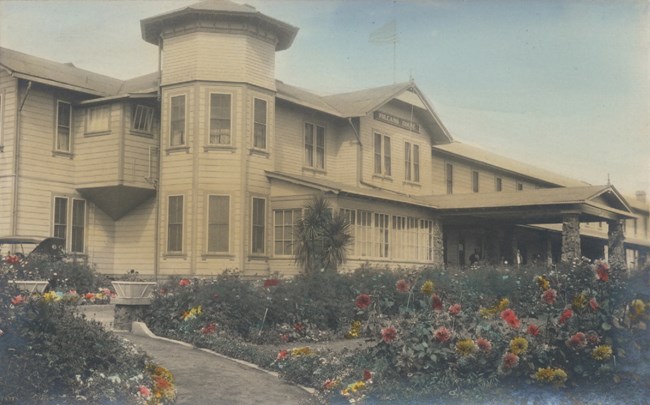
1921 RenovationsIn 1921 the inn grew again, this time exponentially.The Interisland Steamship Company had bought out ownership of the hotel and began to invest large sums of money into it. The 1877 section of the building was removed from the 1891 Victorian addition and rolled back to where it currently houses the Volcano Art Center. A massive two-story wing was then added to the Victorian addition, bringing the number of rooms from 25 to 104. This grand hotel operated under the Interisland Steamship Company until 1932. A lack of tourism due to the Great Depression forced the company to sell the hotel at a sheriff's auction. George Lycurgus, sole bidder and a previous manager of the hotel, purchased the building for $300. “Uncle George”, as he later became known, would go on to manage the hotel until his death in 1959. Lycurgus hosted celebrities such as Princess Victoria Kaulani, President Franklin Delano Roosevelt, Amelia Earhart, and Vice President Charles W. Fairbanks in this building. The building he purchased, however, would only last until 1940. 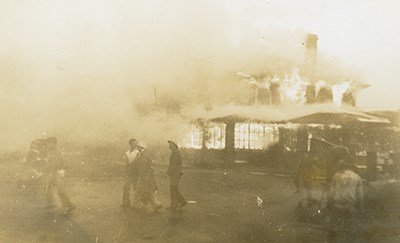
1941 New Volcano HouseOn February 7, 1940 the Volcano House burnt to the ground. A kitchen fire raged out of control and claimed the entire building. The next day, Volcano House was open for business as the smaller 1877 building was pressed back into service to accommodate guests.While the coals still smoldered, George Lycurgus began the process to build a new hotel. He commissioned Maui-born architect Charles W. Dickey to pen the design. Dickey was the foremost Hawaiian architect at the time; best known for designing the Alexander & Baldwin Building, Halekulani Hotel and Kamehameha Schools Honolulu Campus. On November 8, 1941, the new hotel opened for business. This hotel, located across Crater Rim Drive at the caldera’s edge, hosted a fair share of significant guests. The list of names included Dwight D. Eisenhower, Harry S. Truman, Dr. Charles W. Mayo, John F. Kennedy and Richard M. Nixon as well as many others. 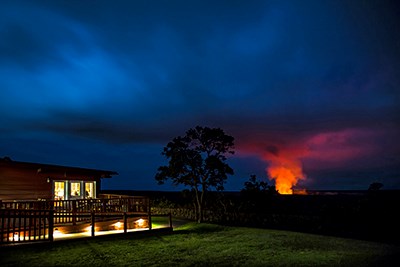
Today, the legacy of this historic hotel continues. As they have done for over 170 years, people flock to Kīlauea to experience the wonder of nature at work. As it has always done, Volcano House Hotel provides a good meal and warm hearth to those that make the journey. 
Browse the Historic Guest RegistersThe historic guest registers of the Volcano House hotel have been digtized and are available online in PDF format. Spanning from 1865-1922, hotel guests signed these registers and included detailed illustrations, anecdotes from their visits, calling cards, poems, and comics.Learn more about the historic guest registers of the Volcano House |
Last updated: July 28, 2025
